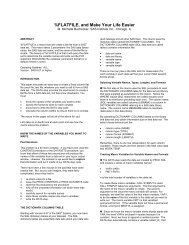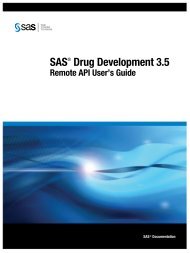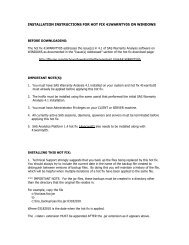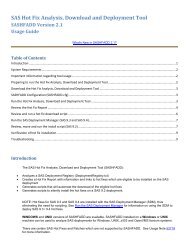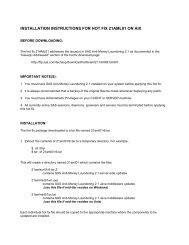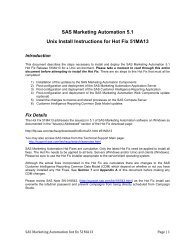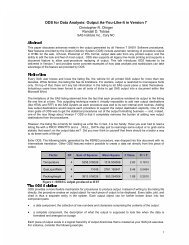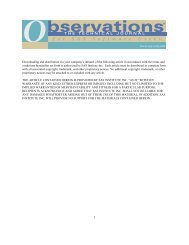SAS 9.3 Web Applications: Clustering - Index of - SAS
SAS 9.3 Web Applications: Clustering - Index of - SAS
SAS 9.3 Web Applications: Clustering - Index of - SAS
Create successful ePaper yourself
Turn your PDF publications into a flip-book with our unique Google optimized e-Paper software.
20 Chapter 3 / JBoss <strong>Clustering</strong><br />
Application Target<br />
sas.wip.admin<strong>9.3</strong>.ear This <strong>Web</strong> application can be clustered, but you might prefer to<br />
deploy it to the stand-alone server because it is not used by<br />
business users.<br />
sas.wip.apps<strong>9.3</strong>.ear Target all servers in the cluster.<br />
sas.wip.resources<strong>9.3</strong>.ear Target all servers in the cluster.<br />
sas.wip.scs<strong>9.3</strong>.ear Target all servers in the cluster.<br />
sas.wip.services<strong>9.3</strong>.ear Target all servers in the cluster.<br />
sas.workflow<strong>9.3</strong>.ear Target all servers in the cluster if you have performed the steps<br />
in “Reconfigure <strong>SAS</strong> Workflow” on page 9. Otherwise, target the<br />
stand-alone server.<br />
Configure Additional JBoss Server<br />
Instances<br />
Configure Port Numbers<br />
JBoss AS 4.2.3.GA and JBoss EAP 4.3<br />
1 Edit the <strong>SAS</strong>Server2\conf\jboss-service.xml file. Change all instances <strong>of</strong><br />
<strong>SAS</strong>Server1 to <strong>SAS</strong>Server2 as shown in this example:<br />
<br />
<br />
<br />
<strong>SAS</strong>Server2<br />
<br />
<br />
<br />
C:\jboss\server\<strong>SAS</strong>Server2\conf\port-bindings.xml<br />
<br />
<br />
org.jboss.services.binding.XMLServicesStoreFactory<br />
<br />
<br />
2 For vertical cluster deployments, with multiple instances <strong>of</strong> JBoss on the same<br />
machine, edit the <strong>SAS</strong>Server2\conf\port-bindings.xml file to avoid port<br />
conflicts. Change the instances <strong>of</strong> ports-01 to <strong>SAS</strong>Server2. This change sets<br />
<strong>SAS</strong>Server2 to use a unique set <strong>of</strong> ports. All the ports are incremented by 100<br />
over the ports used by <strong>SAS</strong>Server1. This typically results in <strong>SAS</strong>Server2 using<br />
port 8180 for HTTP. See this example:





